Rudolph Anton Bartley |
Born: 09 May 1851
|
Died: 08 March 1927
|
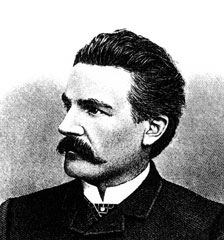
|
 |
Rudolph was the youngest of three children of Gebhard Bertele and his first wife, Josephine Ganter.
Rudolph emigrated as a child of two with his parents and two older brothers. They departed from the port of Antwerp on the Colombo. The ship left Flushing on 18 July 1853 with 258 passengers. It arrived at New York City on 29 August 1853, so the voyage took six weeks.
His family first settled in Perrysburg in Lucas County, Ohio, but moved after two years to Oregon Township. His mother died when he was seven years old. He attended DeBolt School District 5 and worked on his father's farm.
In 1868, at the age of 16, he left the farm and became an errand boy in the H. and F. Barnes grocery store at St. Clair and Adams streets in Toledo, Ohio. He had agreed to send home fifteen dollars a month, in lieu of his services on the farm, until he turned 21. At first, however, he was paid only eight dollars a month, and went into debt for the remaining seven. He soon received a promotion to fifteen dollars a month, which he sent home to his father. Another promotion enabled him to pay off his debt, and at the end of the first year, he was earning twenty-five dollars a month in the general store of J. A. Spyer, located at the corner of Orange and Summit streets. Later, he received thirty-five dollars a month, and was able to save $200 by the time he was 21.
In 1872, Rudolph and Enos Cousino opened a grocery store, called Cousino & Bartley, in a two-story building at 307 Summit Street. For several years, they did all the work, and saved on expenses by sleeping in the store at night. They also used an old red push cart, with the store's name painted on the side, instead of a delivery wagon.
After ten years, Rudolph purchased his partner's interest in the business and became sole proprietor. He immediately expanded by purchasing the adjoining double store of J. C. Wuerfel. His wholesale and retail grocery business now occupied 303, 305, and 307 Summit Street.
In 1887, he moved the business to larger quarters, occupying the five-story Messinger Tobacco Building at 272 and 274 Summit Street. The business also became an exclusively wholesale operation. In 1897, he constructed a two-story warehouse at one end of the building, and a year later added a five-story building to the other end. This group of buildings occupied the entire block from Lynn to Cherry street on Summit.
In 1908, the buildings were destroyed by fire, and the business moved to temporary quarters at Monroe and St. Clair. Rudolph then constructed the Bartley Building in 1914. It was a fire-proof structure, located at the corner of Washington and Ontario streets. Its seven stories had floor space of more than 5½ acres. It is shown in panel one below.
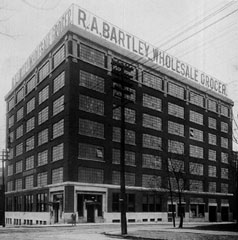 |
 |
The business was incorporated in 1921 under the name of the R. A. Bartley Company, and Rudolph served as president until his death. In 1903, he was one of the first businessmen in Toledo to give his employees a profit-sharing plan. In 1921, each worker received a block of stock in the new company.
In 1875, Rudolph had married Harriet Josephine (Hattie) Barnes (February 1852 - 2 December 1928); she appears in panel two above. The wedding took place in Adrian, Michigan. She was the daughter of Dr. L. B. Barnes and Olive Leaf Evans, and was born in Steuben County, New York. She worked as a school teacher in Calhoun County, Michigan. She was previously married to a man named Dutton, and had a child from that marriage:
Rudolph and Hattie had no children of their own, but they raised Virginia, the daughter of Hattie's son. They also decided to adopt a boy from the Franklin County Orphan's Home. They chose a boy named Harry, but upon learning that he had two brothers in the orphanage, named Frank and David, they decided to adopt all three.
Hattie played an active role in her husband's business, working as an accountant and bookkeeper. The company eventually became the largest individually owned grocery business in the Midwest.
Rudolph and Hattie were members of the First Baptist Church. In the early 1900s they donated $200,000 to the church, making possible the construction of the building on Collingwood near Central Avenue. They also contributed $50,00 to the Baptist Old Folks home and $10,000 to the Salvation Army. Rudolph also provided his blind brother, Fred, with a home and housekeeper.
In 1905, Rudolph built the Bartley House at 1855 Collingwood Avenue, shown in panel three below. The carved limestone exterior was inspired by the classicism of the French Renaissance. Everything was symmetrical, with carved pediments topped with obelisks. The roof was red tile, with its peak 65 feet above the ground. According to Speck (2002), "The Bartley House was viewed disapprovingly by many Old West Enders; they thought it was just too grand. The Bartleys remained simple people at heart and certainly more than one dowager had to reach for the smelling salts upon hearing the rumor that Mrs. Bartley was seen shelling peas on the front porch" (p. 122).
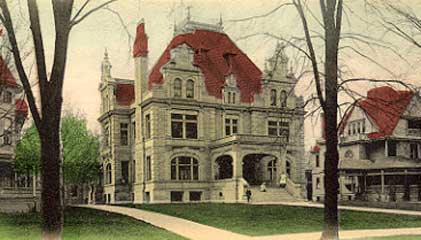 |
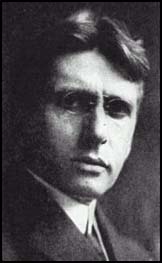 |
In 1907, Rudolph was the Republican candidate for mayor of Toledo. He easily won the Republican primary on 26 September, and vowed, if elected, to abolish gambling halls and wine rooms, and to close saloons on Sundays. His principal opponent was Brand Whitlock (1869-1934), a lawyer, author, and independent reform candidate who was running for reelection. He appears in panel four above. During the campaign, many Democrats decided to back Whitlock. Of nearly 27,000 votes cast on 5 November, Whitlock received 59%, and Bartley only 34%. (Whitlock was later appointed as minister to Belgium by President Wilson, and played an important role in relief efforts during World War I.)
Rudolph served as president of the Toledo Business Men's Chamber of Commerce, the Toledo Board of Education, and the Adams Street Mission. He directed the Toledo Humane Society for many years, and served on the Toledo Commerce Club. He was also a director of the National Bank of Commerce. He was a 32nd degree Mason, and a member of the Toledo Club and the Toledo Yacht Club.
Rudolph died at age 75 from apoplexy and chronic intestinal nephritis at his home. He had been ill for two years, but kept working until a few months before his death. He was interred on 10 March 1927 in the Bartley family mausoleum in Woodlawn Cemetery in Toledo, shown in panel five below.
Hattie died at age 76, and was also interred in the family mausoleum in Woodlawn Cemetery.
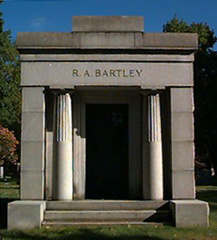 |
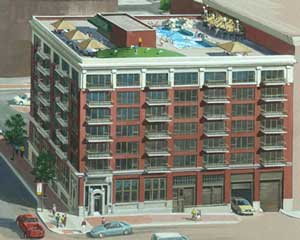 |
The Bartley House was used as a funeral home for many years. It was later occupied by offices. One of the stone parapets collapsed in 1977, and for many years it sat vacant and derelict, stripped of its staircase, paneling, and mantelpieces. Threatened with demolition several times, it was rescued as part of the Museum Place redevelopment project in 1996. The 10,000 square-foot house was converted into 10 apartment units.
The Bartley Building on Washington Street was sold to Lamson Brothers in the 1940s, and turned into a department store. The store operated until the early 1970s, and the building was purchased by Willis Day, Inc. in 1976. It has now been transformed into Bartley Lofts, consisting of 49 1-3 bedroom condominium units, scheduled to open in spring 2005. An artist's conception of the development is shown in panel six above.
| Index | Sources |